View current page
...more recent posts
As I've mentioned a few times, I recently acquired jenghizkhan's Sidstation synthesizer, which incorporates a working vintage sound chip from the Commodore 64, the "legendary" home computer used by many geeks and/or gamers in the '80s. The Swedish company Elektron built only about a 1000 Sidstations due to a limited supply of the chips--it recently found another 100 and the machines were sold just like that. A Macintosh SE user back in the day, I have no attachment to the Commodore and am actually not that interested in recreating game sounds per se, but I am intrigued by the manufacturer's claim that the hacker community explored every permutation and limitation of the chip's sound-making potential, or words to that effect. How many products can you say that about? And in any case, the Sidstation is more than just a chip, it's a full blown synth with many levels of programming and some incredibly interesting full bodied, but all fairly dirty and noisy, sounds.
I'm taking my time about plunging into the inner mysteries of this instrument. Changes to presets or "patches" are done on a tiny LCD screen--with only slightly more characters than a cell phone. I've been exploring the patches that came with it, changing settings and sounds with the machine's few knobs and running various sounds and MIDI files (including my tunes) through it--all the while teaching myself more about the rudiments of synthesis from books, as well as some other hardware with more buttons to push and dials to turn. Also, I've been nervous about crashing it and not knowing what to do next. jenghiz sold it to me with about 90 presets and a CD that I thought had only back-up files. I was a little disappointed that so many of the patches were sequences--i.e., someone else's tunes that you could use like an arpeggiator to play under, or triggered by, your own melodies.
Getting to the point of my story, I crashed the machine the other night. The patch database was completely locked up, so I had to erase all the presets. I downloaded MIDI-OX, which is a MIDI file managing program, to my PC and opened up the CD. Lo and behold, there were several hundred more patches on the CD I didn't even know I had. I successfully did a MIDI dump and reloaded the Sid with about 90 new voices, most of which are not sequences! It feels like Christmas around here. I know the hackers are laughing but give me my simple pleasures. Eventually I'll have my real rite of passage and start seriously tweaking these patches.
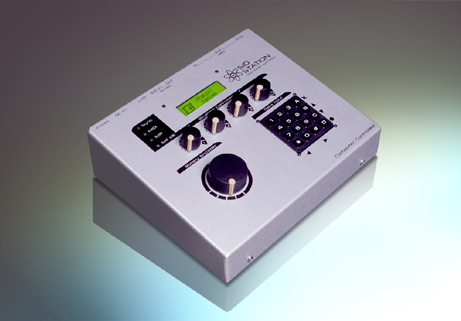
For a later time: why are sounds so much more interesting to me than all the colors and textures of Photoshop, et al? I've gone deeper into sound technology in the past six months than I've gone in years of working with imaging software. With the latter I always felt (and still feel) like I could do everything I wanted to do with just the rudiments: 256 colors and a few basic tools.
Oh, hell, I'll go ahead and attempt to answer this. First, I can draw and paint pretty well (I'm about to choke on this modesty) so I don't feel I need the tech to augment my skills, whereas I am only an adequately dextrous musician and thus more dependent on the tech to make music I can hear but not necessarily play. (Just for the record: hand skill is not a requisite for any art but might have a bearing on relative levels of confidence or cockiness.) But I think even more important than the dexterity issue, electronic music hooks me more on a gut, emotional level than electronic art: I prefer it more as a consumer and am therefore more willing to learn about it as a producer. Ouch, I said it. But then, I've cycled back and forth between dj'ing/music crit and studio art/crit since college days so this is probably just a phase. OK, that's about all the autobiography this blog can stand.
"The Star Pools" [4.2 MB .mp3]
Announcing the "Thomas Gradgrind Award"
This week's Gradgrind goes to Michael Kimmelman of the New York Times, for the last paragraph of his "Greater New York 2005" review:
It's good, in this context, to find a selection of Steve Mumford's painted dispatches from Iraq, plainspoken journalistic pictures of a throwback kind. They announce a mature artist looking closely at what is urgently unfolding around him. Their traditional sobriety stands out in a show that, like the burbling young art world now, seems gladly co-opted and almost too able to please.Top hole, Mr. Kimmelman. Top hole. Our lady Queen Victoria would be most impressed, Indeed, one wishes to see young artists be mature and perspicacious in their craft and not susceptible to influences of the fleeting and trivial sort. And all the better if the illustration in question is in the illustrious service of the Empire, what ho? (Tip of the top hat to bill for finding this most stout and exemplary paragraph.)
Another "Greater New York" (2000) alum: Nina Katchadourian
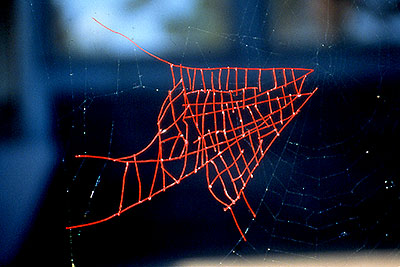
Nina Katchadourian at Debs & Co., New York, NY
by Tom Moody
("Author's cut" of a review originally published in Artforum, Summer 1999)
Nina Katchadourian's recent work, documented in photographs and videotapes, consists of trivial or inept "repairs" to flora and fauna, suggesting the efforts of a clueless amateur field biologist. In Renovated Mushroom (Tip-Top Tire Rubber Patch Kit) (all works 1998), the naturally occurring cracks on mushroom surfaces have been fixed with multicolored tire patches, converting the caps into ridiculous-looking polka-dotted tuffets; in Transplant, a plant's missing leaves have been replaced with membranous insect wings, restoring its symmetry but turning it into a part-animal, part-vegetable monstrosity. Combining the callous experimentation of H. G. Wells's Dr. Moreau with the suburban puttering of Martha Stewart, these projects also send up Andy Goldsworthy's intricate arrangements of rocks and leaves in arcadian settings, which use shamanistic ritual as a pretext for lush photographic set-ups.
Especially reminiscent of Goldsworthy was the "Mended Spiderweb" series, for which Katchadourian sought to restore incomplete areas of large outdoor webs (these were often not the result of any damage but simply gaps in the overall pattern left by the spiders for their own mysterious reasons). Using tweezers and glue, she introduced individual strands of starched bright red thread into a web. The resulting crisscrosses of thick red lines loosely continue the web's pattern, but the photographs make clear that what began as links between interrupted strands often took on lives of their own, seeming to float in the air as "drawings"--semi-abstract, Paul Klee-like pictograms. Mended Spiderweb #8 (Fish-Shaped Patch) really does look like a fish, and certain breaks in the web's network of strands were obviously left "unmended" so that these contours might be retained. Mended Spiderweb #19 (Laundry Line), with its glowing arc of hieroglyphics spanning two webs, features more instances of selective repair. Hovering in gossamer filaments, these thread works are a fragile pas de deux of human and natural effort, so compelling they almost don't need their tongue-in-cheek backstory of "web repair."
Whether one sees them as ironic gestures or exquisite drawings in their own right, the works in this series are tactless invasions of the spider's domain, a fact that Katchadourian readily admits in an accompanying catalogue essay. "I often caused further damage," she writes, "when the tweezers got tangled in the web or when my hands brushed up against it by accident." And while we normally don't know how nature feels about human attempts to "help" it, Katchadourian got immediate feedback. The morning after she made her first patch, she found the threads lying on the ground and realized to her surprise that the spider had pitched them out of the web during the night, like a body rejecting a transplant. This continued to happen with subsequent "repair" jobs, and she eventually succeeded in capturing the rejection process on tape. In the ten-minute video GIFT/GIFT, the viewer watches in amusement as a spider scurries around its web, removing threads as quickly as the artist inserts them. If one sees Katchadourian's project as a kind of New Age-y drawing, then the arachnids become happy collaborators in a cycle of creating and wiping the slate clean; if you take the work ironically, they're environmental "victims" who don't need the help, thanks. It all depends on how you spin it.
Above: Nina Katchadourian, Mended Spiderweb #8 (Fish-Shaped Patch) (detail), 1998, C-print, 20" X 20"
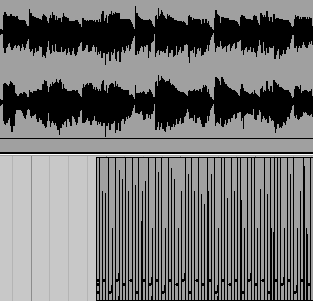
"The Elect Tribe" [mp3 removed].
A catchy Korg drum-and-bass melody interpreted in a dark, psychedelified electro fashion with enthusiastic drumming by a friend's nephew.
Still Emerging After All These Years
With MOMA/PS1's "Greater New York, the Return" we are once again faced with that slippery concept of when an artist "emerges," which leads to oddities such as Scott Grodesky emerging twice in the pages in Artforum, in 1992 and then 12 years later. Why are we faced with this issue? Because "emergence since 2000" and "working in the New York area" are the only stated themes for the show. Important, career launching exhibitions used to have core ideas, reflected in titles such as "Primary Structures," Douglas Crimp's "Pictures," and "The Intrasubjectives"--OK, the latter isn't exactly on anyone's lips but the show included the major AbEx'ers. But since all the powerhouse academics have fled the artworld after using it as a seedbed for pet sociological theories in the '80s and '90s and ultimately killing the soil, and quirky individualism at the curatorial level isn't tolerated in the US anymore for a variety of political reasons, what we get are full time functionaries working in teams, and the only thing they can all agree on is geography and the date.
Yet arguably they botched even the latter, since one could make a strong case that all of the following GNY2005 artists emerged in the '90s and not the 2000-2005 period: Michelle Segre (Elizabeth Koury project room in '93 and Roberta Smith-reviewed two-person show at Lauren Wittels in '96), Randy Wray (solo at Kagan Martos in '96), Meredith Danluck (Andrew Kreps '97), Jason Fox (Feature '99 and group shows starting in '90), Robert Melee (Kreps '98, White Columns White Room '95), Wade Guyton (Kreps project room '99--yes, this one's a squeaker). Corey McCorkle, Steve Mumford, and Sue de Beer were also showing quite a bit in the late '90s. Whether or not the artists had solos or project rooms, all of the above were in group shows and many were written about in not very obscure publications such as Artforum and the New York Times. The upshot of all this isn't that it's unfair for curators to stretch an artist's period of emergence (and I know and/or have written about many of these artists and am happy they're still emerging) but that emergence as a criterion for a major museum exhibit is stupid and should be retired.
"Greater New York" alum: Jesse Bransford
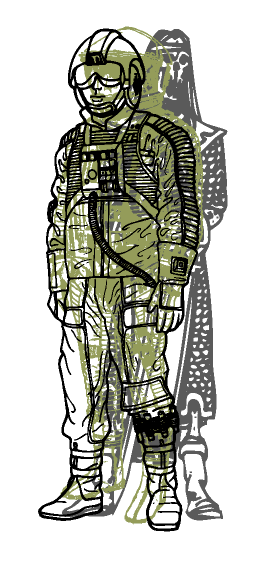
Continuing an impromptu, on and off series highlighting artists from "Greater New York" (2000), in the "subversive just-past" spirit of this press report. Above, a 2001 image by Jesse Bransford titled Hero; below, an anamorphic drawing from his show last year at Feature. In the '90s Bransford mixed Patrick Stewart, Marshall Herff Applewhite, and various Excelsior and/or Constitution-class Federation starships in with his dense layerings of medieval imagery and cabalistic diagrams, and the pop culture element was missed in the 2004 exhibit, which was technically polished and almost willfully mature. This mirror piece, however, is a tour de force: if you gotta grow up (a stretch in this culture, I know) this is the way to go.
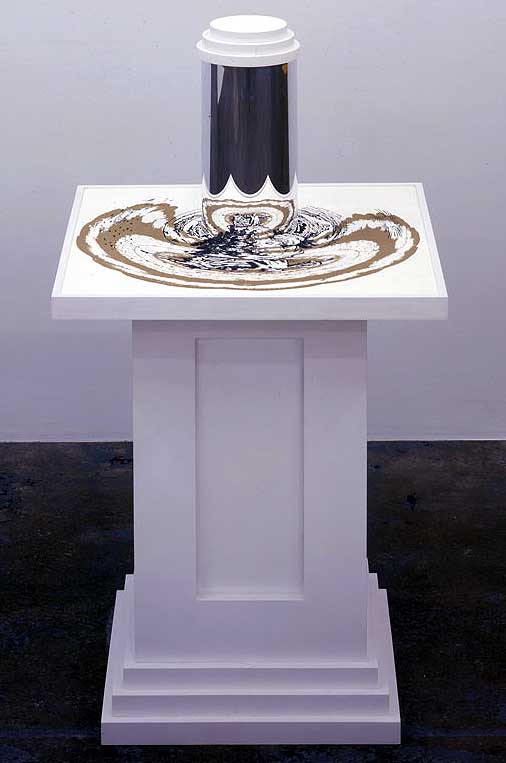
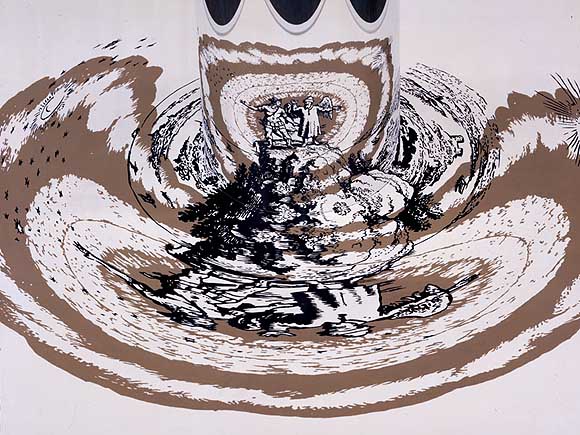
"Greater New York 2005" to Revisit Previous Group of Artists
The Museum of Modern Art's alternative space, PS1 in Queens, announced today that "Greater New York 2005" will consist entirely of artists from the 2000 exhibition "Greater New York." "We wanted to see what all our artists were doing five years later," said PS1 director Alanna Heiss, "and frankly we're sick of this 'fresh young talent' paradigm." She says she fears that New York is "becoming like LA, where the scene is centered around artists still in grad school" and protested the "increasing infantilization trend" of the rival 2004 Whitney Biennial. At an impromptu press conference, she read the following quote from a 1987 Dan Graham essay as further justification for the Museum's somewhat unexpected and daring project:
According to [Walter] Benjamin, "progress," the 19th-century scientific and ultimately capitalist myth, is expressed in commodities, fashion goods which "produce a sense of eternal newness." This makes progress a mythical goal, never to be reached, for there is always the new and it is always superseded by the next new. For Benjamin, then, progress is actually a state of stasis. And yet it is this very stasis that makes the recovery of the just-past potentially subversive.Below, images by "Greater New York" artist Michael Phelan, then and now:
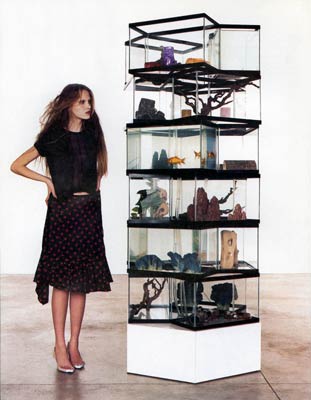
Michael Phelan, from the "Driftwood and Dried Arrangements" series shown in "Greater New York" (2000)

Michael Phelan, from the "Bears" series, to be shown in "Greater New York" (2005)
